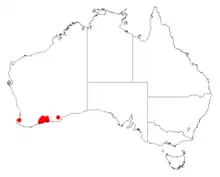Acacia ingrata
Acacia ingrata is a shrub belonging to the genus Acacia and the subgenus Phyllodineae that is endemic to south western Australia.
| Acacia ingrata | |
|---|---|
| Scientific classification | |
| Kingdom: | Plantae |
| Clade: | Tracheophytes |
| Clade: | Angiosperms |
| Clade: | Eudicots |
| Clade: | Rosids |
| Order: | Fabales |
| Family: | Fabaceae |
| Clade: | Mimosoideae |
| Genus: | Acacia |
| Species: | A. ingrata |
| Binomial name | |
| Acacia ingrata | |
 | |
| Occurrence data from AVH | |
Description
The diffuse, spreading, multi-stemmed and pungent shrub typically grows to a height of 0.15 to 0.5 metres (0.5 to 1.6 ft). It has light grey coloured bark on glabrous to lightly haired branchlets with persistent stipule bases appearing as tooth-like projections. The sessile, patent to slightly reflexed, green phyllodes have a narrowly triangular to narrowly oblong shape with a length of 6.5 to 20 mm (0.26 to 0.79 in) and a width of 1 to 2 mm (0.039 to 0.079 in) with an obscure midrib.[1] It produces cream-white flowers from September to January.[2] The inflorescences occur on one or two headed racemes that have an axes length of 1 to 2 mm (0.039 to 0.079 in). The sparse spherical flower-heads contain five to seven cream to white flowers. The seed pods resemble a string of beads and have a length of up to 5 cm (2.0 in) and a width of 4 to 5 mm (0.16 to 0.20 in). the pods contain dull dark brown seeds with an elliptic shape that are 4 to 6 mm (0.16 to 0.24 in) long.[1]
Distribution
It is native to an area along the coast in the South West and Goldfields-Esperance regions of Western Australia where it grows in gravelly lateritic clay-loam and sandy soils.[2] The bulk of the population is found on the south coast between Mid Mount Barren near Ravensthorpe in the west and Young River in the east[1] with an isolated population found on the west coast around Busselton.[2]
See also
References
- "Acacia ingrata". World Wide Wattle. Western Australian Herbarium. Retrieved 11 May 2019.
- "Acacia ingrata". FloraBase. Western Australian Government Department of Parks and Wildlife.